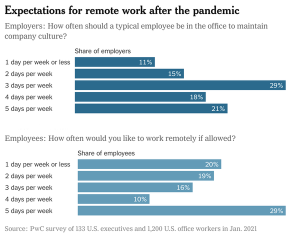Do you know what team attrition is, how to calculate it, and why it matters? When you look at the employee attrition rate, it gives you insight into the rate at which employees are leaving a company. In most cases, you’ll see it listed as a percentage.
Team attrition is a gradual reduction in the number of members as workers resign or otherwise leave the workplace and are then not replaced. If good employees are leaving a company and can’t be replaced, this can cut down on the effectiveness or strength of your team. As the team attrition rate rises, it can be more challenging to meet all your objectives and goals.
While there is optimism we will soon emerge from the year-long pandemic, executives fear an unparalleled wave or uptick in attrition. Economic growth, rapid hiring, and a rising sense of security are leading employees to ask if their current company provides the connection, collaboration and mission they are seeking.
Several studies show that team attrition may increase or already has. Instead of being around 12 to 15% annually, the number could reach 25 to 50%. A “turnover tsunami” is expected to explode as the pandemic ends, and over 50% of workers look for new jobs.
About 25% of workers have plans to look for a new job following the pandemic. However, this number is even higher for millennials, where it reaches 34%. It’s important to be aware of this since the generation is the largest workforce available right now.
There are several drivers of the uptick in attrition:
– Career advancement and higher pay
Prudential’s study found that of those planning to leave their current job, 80% are concerned about career growth. Top performers are most concerned about their growth and no longer feel geographically tied to local employers in a remote world.
– Lower engagement
A recent study found that 46% of respondents feel less connected to their company, and 42% say company culture has diminished since the start of the pandemic. Just 21% said they are very engaged at work.
– Vast divide in expectations between bosses and their teams
PWC uncovered a large gap in expectations for remote work after the pandemic:

A survey by Blind, an anonymous network for professionals, illustrated potential implications well. At the end of March, out of 3,050 users 35% said they would quit if WFH ended. Interestingly, 11% of respondents said they had “already negotiated WFH forever.”
Leaders must proactively put strategies in place to address rising attrition rates and prevent disruption in their teams. Teams sharing Teamraderie experiences every 8-12 weeks measure stronger connection and engagement, register higher ratings of their team and company and have lower attrition.
Team Attrition vs. Turnover: What’s the Difference?
Now you might be wondering what the difference is between team attrition and turnover. There are some similarities, which makes them easy to get confused with one another. Both team attrition and turnover occur when someone leaves a team or company. This makes it an important metric to consider, especially as losing an employee can create a cost of thousands of dollars or more.
So what makes the two things different? Turnover looks at how quickly employees you will replace leave the company over a certain period. This can include involuntary or voluntary departures from the team.
However, team attrition refers to employees who leave of their own volition and whose role is not filled again. This might occur when someone leaves to go back to school, chooses to move to a new company, or retires and leaves the workforce entirely.
How to Calculate Team Attrition Rate
Now that you understand what team attrition is, you should be aware of how to calculate it. Thankfully, this is an easy calculation that anyone can do. To determine the attrition rate, take the number of separations divided by the average number of employees. Once you have that number, multiply by 100 to get the team attrition rate.
Attrition rate = (# of separations / average # of employees) x 100
In addition, you can calculate annual or year-to-date rates by adding together all 12 months if you need that information.
What Attrition Means for Your Business
So why does team attrition matter? This number gives you insight into how well you are keeping the talented people on your team. If the rate is abnormally high, people are leaving frequently and not being replaced. On the other hand, a low rate shows you are doing something right as employees are staying in their positions longer.
It’s also important to consider why people are leaving so you can make positive changes to avoid it happening in the future. Some of the most common drivers of higher team attrition include lower engagement, a desire for higher pay and career advancement, and a divide in expectations between bosses and teams.
Calculate your team attrition and then move forward with finding out what might drive it to be higher than usual. Then it’s up to leaders to put solutions into practice that deal with increased attrition. It’s well worth it to keep a skilled team in place.
Teamraderie virtual experiences are designed to cultivate connection and trust in teams. You can reach out to us at team@teamraderie.com or visit our experience finder if you would like to learn more.


